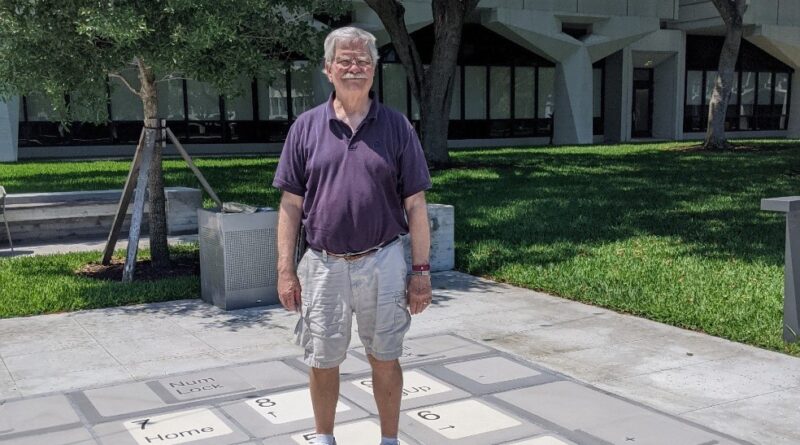Dr. Dave Bradley, Bill Gates & Control-Alt-Delete

By #BOCABAUHAUS
What was it like for employees of IBM to work with Bill Gates in the 1980s, when Gates was in his twenties? In April 2022, we interviewed Dr. Dave Bradley, a former IBM employee who worked at the company’s Boca Raton site, to find out.
Bradley — one of 12 engineers who worked on the original IBM personal computer (PC) — shared several stories about working with the famed business magnate and co-founder of Microsoft.
Dr. Dave & Control-Alt-Delete
Before we focus on Gates, let us consider Bradley himself, the inventor of Control-Alt-Delete.
Bradley (2011) helped develop IBM’s first PC, which at the time vastly outsold its rivals. He writes that, in developing the PC, “I was responsible for the basic input/output system (BIOS), otherwise known as engineering software” (p. 20). He received numerous patents for his work on the PC — patents that earned IBM millions of dollars independent of the company’s PC sales.
These days, Bradley is most famous for inventing Control-Alt-Delete, the “three-key sequence for reset/reboot on the IBM PC” (Bradley, 2011, p. 23). Before Bradley, this key sequence had no special meaning. Bradley says that developing Control-Alt-Delete “was a five-minute job in my 35-year career. It’s the one thing that everybody seems to know about” (University of Dayton, 2012).
According to Bradley (2011), as IBM developed its PC, “lots of new programs were arriving and being tested and as frequently happens, they would quit running and nothing could revive them” (p. 22).
IBM needed a quick way to reset and reboot, so Bradley created a three-key combination that would do the trick, picking “a set of keys that would be difficult to hit by accident” (ibid.). He picked the delete key, DEL, because “Enter was a bigger key, more likely to be hit by accident, and Del is a better mnemonic for the drastic action that’s about to occur” (ibid.).
Reporter Dana Clemens, who has also interviewed Bradley, asked him if he “ever thought about the fact that the thing you created is the thing that people resort to when they are most frustrated with their computers?” (University of Dayton, 2012).
Bradley’s response was perfect:
“I like to be a help in any way that I can. I don’t think they’re mad at me when they do it. I like to think it’s other people that have caused…their problems” (ibid.).
On a side note, we live in Boca Raton, and we like the fact that our home city is also the birthplace for Control-Alt-Delete.
Bill Gates & IBM Boca Raton
In 1980, Bill Gates flew to Boca Raton to make a deal with IBM (Ichbiah, Chapter 8). At the time, IBM was developing its first mass-produced PC, and Gates proposed that Microsoft develop core software for it, including its operating system. IBM agreed to a non-exclusive license for Microsoft’s operating system, and Microsoft was free to sell the operating system to other manufacturers (ibid.). It is possible that Microsoft would never have become nearly as successful as it has had it not been for this agreement in Boca Raton.
Gates and Microsoft proceeded to work closely with IBM, with Gates remarking:
We had a really great interface with the people from the customer (IBM), even though they’re as far away as they could be, down in Boca Raton. The night flight down there is not much fun. We had a lot of fun together. (Bunnell, 1982)
In the years following the licensing agreement, IBM employees — including Bradley — would often fly to Washington State to work with Microsoft. In fact, Bradley traveled to Washington to deliver the very first IBM PC to Microsoft. He remembers that Steve Ballmer, who later became CEO of Microsoft, answered the door when he arrived.
Ultimately, Bradley made the trip to Washington numerous times over the next several years, focusing on PC hardware while Microsoft focused on software. In his travels, Bradley met and worked with Gates.
Bradley remembers that Gates “was very focused, extremely bright, very passionate about his work. And you could just — in his body language — see his intensity. You’d be in a meeting and he’d be there rocking back and forth — just somewhere to displace his nervous energy as he’s focusing on the problem and how we’re going to fix these things” (Boca Raton Innovation Campus, 2021).
When we met with Bradley, he shared several stories about his experiences working with Gates. He was careful to note, in advance, that since these events happened 40 years ago, he might be misremembering some details.
We have included the first of his stories below, italicizing his words and kept our interruptions in standard font.
For some background, it is important to know that Microsoft had several IBM PC prototypes at their headquarters, which they were using to develop software and their operating system. In 1981, Bradley received a phone call informing him that one of these prototypes, then at Microsoft, was not working properly.
Dr. Dave’s First Story About Bill Gates
So, some Thursday afternoon, probably in January of 1981 or thereabouts, we get a phone call. They said, “The power supply went out on one of the two prototypes.” By that time, we had a couple of decent systems. They said, “Okay Dave, put this power supply in your suitcase and get on the plane Friday morning and go out and fix it.”
Bradley traveled to Microsoft’s headquarters in Bellevue, Washington, to fix the power supply on prototype IBM PC.
I’m out there on Saturday. I’m in their place. I’m fixing the machine, making it work all real well. And then I just spent Sunday there — the only sunny day I ever spent in Seattle traveling to Microsoft.
After product meetings on Monday, Bradley planned to fly back to Florida at 8 a.m. on Tuesday.
So, at about 5 a.m., I stopped by Microsoft because the IBM software guy said Microsoft owes us a new release of BASIC. We’ve already had some releases. They owe us a new one. And, of course, in 1980 there was no Internet. There was no dial-up modem way to do it. You essentially had to mail diskettes. The IBM guy said, “You’re coming back. You bring the diskette.” So, I go in at 5 o’clock.
The IBM PC — the prototypes — are contained in a little room way off to the side. They have one floor of the One National Bank Building in Bellevue. They have maybe 30 people working for them at the time. The room that this was in had originally been in their shipping department. So, when we set up originally, we shared the room with great big, huge bags of polystyrene packing peanuts.
So, I go in there, and Bill [Gates] is lying on the floor. He’s got printouts in front of him and he’s going through and marking them up by hand.
I say, “Hi Bill, I’m here to pick up the latest BASIC. I gotta get to the airport.”
He says, “I have a few minutes, Dave. I just have a few more changes to make.”
And so he is marking it up, and then he starts typing stuff in. And then finally around 6 o’clock, I say, “Ah, Bill — you know, I’ve got to get going if you want to have this delivered today.”
So he says, “Okay, okay.” And then he fixes it all up and finally, I’m out the door at 6:15 or something like that and made it to the airport on time to go back and give the guys their latest version of BASIC, which apparently didn’t work all that well and they had to send another one shortly.
But when people say, “Was Bill actually involved?” He was there. He was writing the code for it. At 5 a.m. He was making it work on the IBM PC.
Dr. Dave’s Second Story
The second story Bradley told us only briefly features Gates, but we appreciate the tale nonetheless. In 1982, Bradley was working on the second computer in the IBM line — the IBM PC/XT. In our conversation, Bradley remarked that “I was managing the BIOS department at that point. I had six or seven people working for me.”
At the time, Joe Sarubbi was project manager for the PC/XT. Another former employee of IBM, Justin “Jud” H. McCarthy (2020), described Sarubbi thusly:
Although, up front, he came across as a tough New York Italian mafia God Father [sic], I learned quite early on, that if he liked and trusted you, he could really be a cream puff inside. (p. 588)
According to McCarthy:
[A] famous Sarubbi saying was, “Do you want me to make you a soprano?” This would be in concert with the slowly clutching his fist toward your private regions, as he looked you straight in the eye. (ibid., p. 589)
While IBM was developing the PC/XT, the company was still working closely with Microsoft, which was itself working on DOS 2.0 — a new version of its operating system intended to be released with IBM’s next PC.
Yet, as Bradley noted in our interview, Microsoft was having “a lot of trouble with DOS 2.0.” He adds that Sarubbi was “unhappy with the progress that Microsoft [was] making.”
Here is where Bradley’s second story really begins. Again, we have italicized his words below:
And so, what Joe decides he’s going to do is, we’re going to go out to Microsoft every week. And [he tells me], “Dave, you understand software. You’re coming with me.”
Tuesday evening, we would go up to West Palm Beach. We would get on the flight.
The next day, Wednesday, we would meet with Microsoft. And Joe Sarubbi — first of all, think Sicilian mafia. And second, Joe is about 6’2, 6’3, and at least 300 pounds … And so [Joe] sits at the table. And there’s Bill Gates, sitting at the other side of the table. And Bill Gates is maybe 150 pounds soaking wet at that time. And he’s rocking back and forth. And Joe can just go there and say, “You’re going to have it ready WHEN? What about this problem? How are you going to fix THAT? What about this problem?” After a while, Bill quit coming to the meetings.
Bradley adds that other Microsoft employees replaced Gates at the meetings.
We then get on the red-eye Wednesday night and fly back to Boca.
Dr. Dave, Gates, & Control-Alt-Delete
In 2001, Bradley was invited to speak as part of a panel at an event celebrating the 20th anniversary of the IBM PC. Also on the panel were Gates; Andy Grove, the CEO of Intel; Daniel S. Bricklin, the creator of VisiCalc; David Bunnell, the founder of PC Magazine; Rod Canion, cofounder of Compaq; Mitch Kapor, founder of Lotus; and Ray Ozzie, creator of Lotus Notes (cf. Microsoft, 2001).
Bradley remarked:
There were eight participants in the panel. They seated us in alphabetical order, so I was the very first guy to go….It’s a good thing we were in order alphabetically because if we had lined up by net worth I’d be sitting out in the parking lot.
With the panelists in alphabetical order, the first question of the night was for Bradley. The moderator, Brent Schendler, asked Bradley about inventing Control-Alt-Delete.
“[I was] trying to solve a development problem that we had…The only solution you have was turn the power off, wait a few seconds, turn the power back on…I said, ‘I’m writing all this code for the keyboard. Let’s just shortcut it.’ I had originally intended for it to be what we would now call an Easter Egg — just something we were using in development. It wouldn’t be available elsewhere. But then the ‘pubs’ people found out about it. And they were trying to figure out how to tell somebody to start up one of their programs, and they had the answer. Just put the diskette in, hit Control-Alt-Delete, and by magic, your program starts. So, it was like a five-minute job in doing it. I didn’t realize I was going to create a cultural icon when I did it. But I have to share the credit. I may have invented it. But I think Bill made it famous” (emails5com, 2011).
Everyone laughed, knowing that Bradley was at least partly referring to frequently needing to reboot computers with the Microsoft operating system.
The camera operator cut from Bradley to Gates, who just sat there, slightly smiling. To us, it looked like Gates might have been upset, but Bradley says that he wasn’t, really.
Later in our interview, Bradley added that: “When I retired in 2004, [Gates] and Balmer cowrote a letter…It was a very nice letter, saying it was great working with you. Good luck on retirement.”

Dr. Dave Bradley at the former IBM site in Boca Raton.
We took this photo of Bradley after our interview at what used to be the primary site of IBM in Boca Raton. One of the buildings at that site — now part of the Boca Raton Innovation Campus (BRiC) — houses Marcel Brewer’s Coffee Shop where we and Bradley ate lunch. On the patio outside of the coffee shop, BRiC has printed a large-scale replica of IBM’s first keyboard. And BRiC has bronzed the Control, Alt, and Delete keys in honor of Bradley’s work.
Acknowledgment
This essay would not have been possible without the help of the Boca Raton History Museum and its curator, Susan Gillis. Without their help, we likely would never have connected with Dr. Dave Bradley.
References
Boca Raton Innovation Campus. (2021, February 23). Boca Raton tech talks – Technology of radar, IBM Boca Raton and the first PC [Video]. Youtube. https://www.youtube.com/watch?v=4tcYJYkYYv0
Bradley, D. (2011). A personal history of the IBM PC. IEEE Computer, 44(8), 19-25.
Bunnell, D. (1982, February-March). The man behind the machine? PC Magazine 1(1), 16-23.
Emails5com. (2011, January 7). Control-alt-delete: David Bradley & Bill Gates [Video]. Youtube. https://www.youtube.com/watch?v=K_lg7w8gAXQ
Ichbiah, D. (2021). Bill Gates – The story (R.E. Anderson, Trans.). Balecube.
McCarthy, J. H.”J.” (2020). Light Blue: An entry level and mid management perspective of ibm’s evolution through the golden years. Independently published.
Microsoft. (2001, August 8). The IBM PC turns 20. https://news.microsoft.com/2001/08/08/the-ibm-pc-turns-20/
University of Dayton. (2012, October 26). An interview with David Bradley ’71, inventor of control-alt-delete [Video]. Youtube. https://www.youtube.com/watch?v=EvOzBGozDm0




